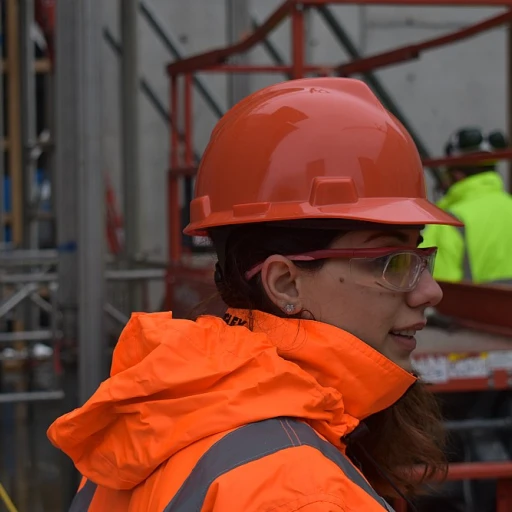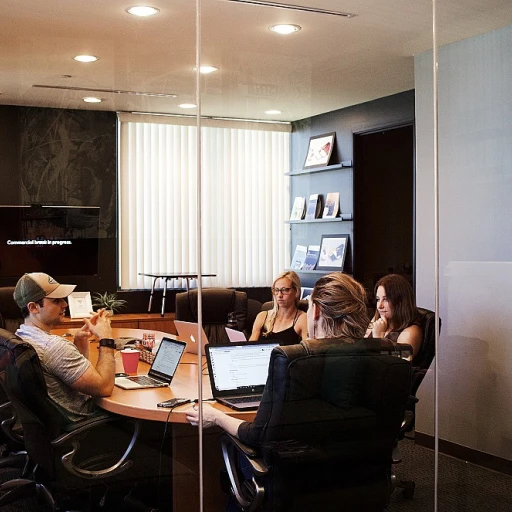Understanding Representative Management
Grasping the Essentials of Management Representation
Understanding representative management is pivotal in the context of change initiatives. In essence, a management representative acts as an intermediary, bridging the gap between the strategy formulated by top management and its execution within an organization. Whether it's in construction projects or any other industry, the representative's role is to ensure that all quality requirements are met and that the project progresses smoothly according to the established management system.
The responsibilities of a management representative extend across various sectors, including construction and medical devices, where they particularly focus on aligning project objectives with organizational quality standards. They ensure that ISO standards are adhered to, playing a crucial role in quality management system implementation. This responsibility involves coordinating management review meetings and facilitating communication among the management team, project owners, and stakeholders to ensure transparency and project success.
In environments such as construction projects, owner representatives are crucial. An owner representative acts on behalf of the project owner to safeguard their interests, ensuring the project meets its specified objectives in terms of quality, time, and budget. The representative's pivotal role is reinforced by their involvement in risk management, keeping tabs on project developments and preemptively addressing potential issues.
The responsibilities associated with management representation are not confined to merely ensuring compliance with organizational standards; they also involve member management and actively engaging stakeholders. The effective integration of representatives can significantly enhance project outcomes, as they ensure clear communication and smooth processes. When a new stakeholder joins the initiative, understanding the nuances of representative management can be invaluable, as highlighted in key steps when a new stakeholder joins your change management initiative.
As change management initiatives evolve, the emphasis on robust representative management will continue to grow, aligning with future trends of harmonizing project management systems with organizational goals. The importance of representative management will become even more pronounced as organizations strive to adapt to dynamic environments and complex project demands.
The Role of Stakeholders in Change Management
Stakeholder Role Dynamics in Change Management
In the realm of change management, the understanding and inclusion of stakeholders play a pivotal role. Stakeholders are the backbone of any change initiative, providing not only valuable insights but also the essential support needed for a successful project execution. Whether in construction, quality management, or other sectors, their involvement determines the seamless adaptation and acceptance of new processes.
A stakeholder in a change project isn't just anyone; it can be the project owner, a member of top management, a quality management representative, or an owner representative. Each has distinct responsibilities, from setting objectives within the management system to ensuring compliance with ISO requirements. The management representative is often tasked with bridging these roles effectively, acting as the catalyst for synergy between the different players involved.
Recognising the responsibilities and influence of various stakeholders within an organization, such as the project manager, can enhance the outcome of initiatives. Their role might include shaping the management review, ensuring alignment with strategic goals, and driving members to meet quality standards.
Moreover, stakeholders in sectors like the medical device industry or construction projects bring specialized knowledge that can be used to inform risk management strategies and refine management systems. Management representatives, for instance, must ensure processes are in place to meet the privacy policy and ISO medical standards. This not only helps in maintaining the integrity of projects but also boosts trust and authority within the organization.
For a change initiative to succeed, the management team must effectively leverage stakeholder input. By doing so, they embrace a holistic approach that accounts for varied perspectives within the organization, ensuring that all involved parties remain engaged, informed, and motivated throughout the project's lifespan.
Strategies for Successful Representative Management
Key Approaches for Effective Stakeholder Representation
Successfully managing representatives in the context of change initiatives requires a range of clear and actionable strategies. When organizations embark on change, the role of a management representative becomes vital in driving these initiatives forward. Here, we'll explore some strategies that can enhance the effectiveness of representative management in various sectors including construction, medical devices, and project management.
- Clarify Roles and Responsibilities: It is essential to clearly define the responsibilities of each management representative. This ensures everyone understands their role within the project, quality management systems, and processes. This clarity helps align the objectives of the organization with the specific requirements of the ISO standards.
- Engage Top Management and Owners: Engaging top management and owner representatives from the outset can significantly elevate the effectiveness of change initiatives. Their involvement is crucial for obtaining the necessary resources and authority to drive improvements and meet organizational goals.
- Institute Continuous Feedback Mechanisms: Establish regular feedback loops, such as management reviews and risk management updates, to monitor how effectively representatives are fulfilling their roles. This helps identify issues early while ensuring timely corrective actions.
- Leverage Technology Systems: Utilizing advanced management systems can enhance communication and streamline processes. Implementing such systems to facilitate the alignment between project managers, management representatives, and all stakeholders can lead to more cohesive decision-making.
- Offer Tailored Training and Development: Providing specific training for management reps tailored to their unique roles within construction projects, medical devices, or member management enhances their ability to fulfill their responsibilities efficiently. This includes training on privacy policy compliance and ISO medical requirements.
- Support Inclusive Stakeholder Engagement: Encouraging open dialogue among all stakeholders, including owner representatives and project managers, is crucial for ensuring diverse perspectives are considered. This can foster a collaborative environment that is conducive to positive change.
Implementing these strategies can help fortify the management system, support project owners, and optimize the performance of representatives. For more insights on boosting employee drive in times of change, visit this article.
Overcoming Challenges in Representative Management
Addressing Representative Management Challenges
Navigating the world of representative management is no small feat, as various challenges can arise when implementing change initiatives. Understanding the unique dynamics within each organization and project is essential to overcoming these obstacles and ensuring the success of the change efforts. One critical challenge involves aligning the expectations of the management rep, the project owner, and the quality management team to ensure the seamless integration of processes. Often, these members of the management system have differing views on priorities and expectations, making it vital to establish clear communication channels and foster a collaborative environment. To effectively overcome such challenges, organizations can:- Empower the Management Representatives: Ensuring that management representatives have the right tools and authority can significantly streamline the project management process. Empowered reps can swiftly address potential issues and ensure compliance with quality and ISO requirements.
- Regularly Review Processes: Conducting management reviews at set intervals provides one way to identify systemic issues early on. It also gives a platform for management reps and top management to voice concerns and adjust strategies as required.
- Adopt an Inclusive Approach: By involving all key stakeholders, including owner representatives, in the decision-making process, the organization can leverage diverse perspectives. This ensures that changes to the management system are comprehensive and consider all aspects of risk management.
- Develop Clear Privacy Policies: Clarity in privacy policies helps in managing expectations and reduces friction amongst the team members involved in sensitive projects, especially those related to medical devices or other ISO-specific construction projects.
Case Studies: Representative Management in Action
Practical Examples of Representative Management in Action
Examining real-world scenarios can provide insightful lessons on the nuances of representative management in change initiatives. Various industries offer diverse challenges and solutions, making them valuable case studies for understanding effective management practices.
Construction Industry Insight
In the construction sector, the role of management representatives is critical for ensuring projects meet quality and safety standards. An owner representative shoulders responsibility for ensuring that construction projects remain on track, meeting the designated requirements within the stipulated time frame. Adequate risk management processes are essential, allowing project managers to anticipate and mitigate potential delays or obstacles. An example of this can be seen in large-scale construction projects where management representatives collaborate with top management to align project goals with organizational objectives, ensuring a seamless integration of quality management systems.
Healthcare and ISO Standards
The healthcare sector presents a unique blend of challenges, especially concerning ISO medical device standards. Management representatives in such contexts must not only ensure compliance with stringent ISO requirements but also advocate for patient safety and quality care. In practice, this means that a management rep often acts as a liaison with ISO auditors, ensuring that all processes align with internationally recognized standards. The implementation of these standards requires an in-depth understanding of quality management systems, further highlighting the role of management representatives in maintaining the organization’s reputation and operational excellence.
Technological Implementations
Within technology-driven projects, management representatives often take charge of overseeing system integrations that adhere to privacy policy guidelines while meeting quality benchmarks. An example here involves the introduction of new software systems, where the management team – including member management services – plays a pivotal role in aligning new technologies with existing operational frameworks. By ensuring representative management at this level, organizations can successfully navigate the complexities of technology adoption, meeting both user needs and quality expectations.
These case studies underscore the multifaceted responsibilities that management representatives hold across diverse industries. From construction projects to ISO-certified medical devices, their engagement is pivotal in fulfilling the requirements of efficient project delivery, hence reflecting the integral connection between representative management and organizational success.
Future Trends in Representative Management
Emerging Trends Shaping the Future
The landscape of representative management in change initiatives is evolving rapidly, influenced by technological advancements and shifting organizational priorities. As we look to the future, several key trends are expected to shape how organizations manage change effectively.
Integration of Advanced Technologies
One of the most significant trends is the integration of advanced technologies into management systems. Tools like artificial intelligence and data analytics are becoming crucial in enhancing decision-making processes. These technologies help management representatives analyze data more efficiently, ensuring that change initiatives align with organizational goals and ISO standards. In construction projects, for example, leveraging these tools can optimize project management by providing real-time insights into project timelines and resource allocation.
Focus on Quality and Compliance
With increasing emphasis on quality management and compliance, organizations are prioritizing the development of robust management systems. This focus is particularly evident in industries such as medical devices, where ensuring compliance with ISO medical standards is critical. Management reps play a vital role in maintaining these standards, ensuring that quality requirements are met throughout the project lifecycle.
Enhanced Stakeholder Engagement
The role of stakeholders in change management is becoming more pronounced, with organizations recognizing the importance of active stakeholder engagement. Future trends suggest a shift towards more inclusive processes, where owner representatives and project owners collaborate closely with management teams to drive successful outcomes. This collaborative approach not only enhances member management but also ensures that the responsibilities of each stakeholder are clearly defined and aligned with the organization's objectives.
Emphasis on Risk Management
Risk management is another area gaining traction in representative management. As projects become more complex, the need for effective risk management strategies is paramount. Management representatives are tasked with identifying potential risks early in the project lifecycle and developing strategies to mitigate them. This proactive approach helps organizations navigate challenges and maintain project quality and timelines.
Conclusion
In conclusion, the future of representative management in change initiatives is poised for transformation, driven by technological advancements, a focus on quality and compliance, and enhanced stakeholder engagement. By staying abreast of these trends, organizations can ensure that their change management processes remain effective and aligned with their strategic goals.











